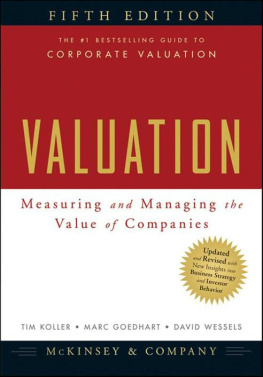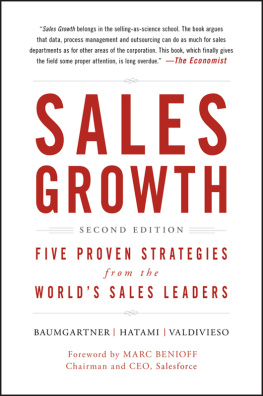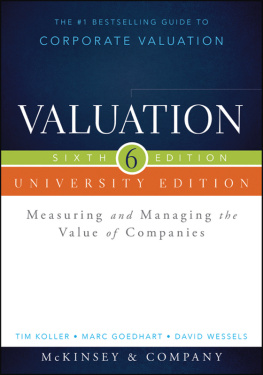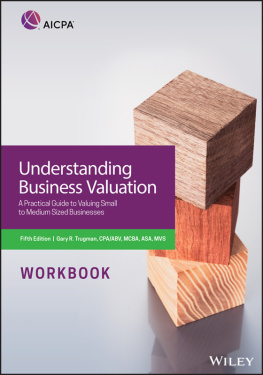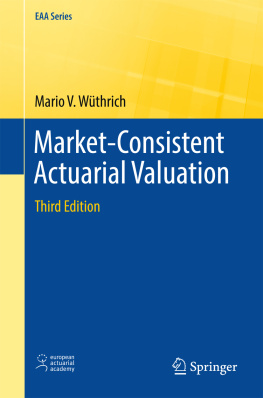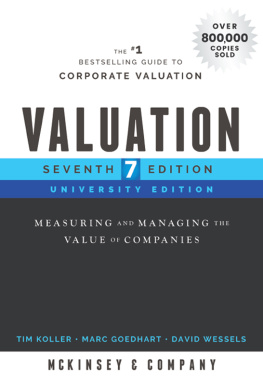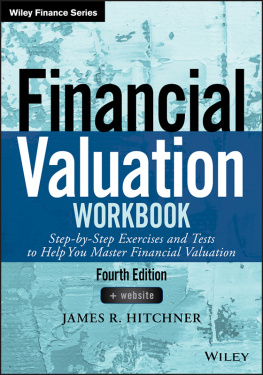Contents
Founded in 1807, John Wiley & Sons is the oldest independent publishing company in the United States. With offices in North America, Europe, Australia and Asia, Wiley is globally committed to developing and marketing print and electronic products and services for our customers professional and personal knowledge and understanding.
The Wiley Finance series contains books written specifically for finance and investment professionals as well as sophisticated individual investors and their financial advisors. Book topics range from portfolio management to e-commerce, risk management, financial engineering, valuation and financial instrument analysis, as well as much more.
For a list of available titles, visit our Web site at www.WileyFinance.com .
Copyright 1990, 1994, 2000, 2005, 2011 by McKinsey & Company. All rights reserved.
Published by John Wiley & Sons, Inc., Hoboken, New Jersey.
Published simultaneously in Canada.
No part of this publication may be reproduced, stored in a retrieval system, or transmitted in any form or by any means, electronic, mechanical, photocopying, recording, scanning, or otherwise, except as permitted under Section 107 or 108 of the 1976 United States Copyright Act, without either the prior written permission of the Publisher, or authorization through payment of the appropriate per-copy fee to the Copyright Clearance Center, Inc., 222 Rosewood Drive, Danvers, MA 01923, (978) 750-8400, fax (978) 646-8600, or on the Web at www.copyright.com . Requests to the Publisher for permission should be addressed to the Permissions Department, John Wiley & Sons, Inc., 111 River Street, Hoboken, NJ 07030, (201) 748-6011, fax (201) 748-6008, or online at http://www.wiley.com/go/permissions .
Limit of Liability/Disclaimer of Warranty: While the publisher and author have used their best efforts in preparing this book, they make no representations or warranties with respect to the accuracy or completeness of the contents of this book and specifically disclaim any implied warranties of merchantability or fitness for a particular purpose. No warranty may be created or extended by sales representatives or written sales materials. The advice and strategies contained herein may not be suitable for your situation. You should consult with a professional where appropriate. Neither the publisher nor author shall be liable for any loss of profit or any other commercial damages, including but not limited to special, incidental, consequential, or other damages.
For general information on our other products and services or for technical support, please contact our Customer Care Department within the United States at (800) 762-2974, outside the United States at (317) 572-3993 or fax (317) 572-4002.
Wiley also publishes its books in a variety of electronic formats. Some content that appears in print may not be available in electronic books. For more information about Wiley products, visit our web site at www.wiley.com .
Cloth edition: ISBN 978-0-470-42465-0
Cloth edition with DCF Model Download: ISBN 978-0-470-42469-8
University edition: ISBN 978-0-470-42470-4
Workbook: ISBN 978-0-470-42464-3
DCF Model CD-ROM: ISBN 978-0-470-42457-5
DCF Model Download: ISBN 978-0-470-89455-2
Instructor's Manual: ISBN 978-0-470-42472-8
About the Authors
McKinsey & Company is a management-consulting firm that helps leading corporations and organizations make distinctive, lasting, and substantial improvements in their performance. Over the past seven decades, the firm's primary objective has remained constant: to serve as an organization's most trusted external adviser on critical issues facing senior management.
With consultants deployed from over 80 offices in more than 40 countries, McKinsey advises companies on strategic, operational, organizational, financial, and technological issues. The firm has extensive experience in all major industry sectors and primary functional areas, as well as in-depth expertise in high-priority areas for today's business leaders.
Tim Koller is a partner in McKinsey's New York office. He leads the firm's Corporate Performance Center and is a member of the leadership group of the firm's global corporate finance practice. In his 25 years in consulting Tim has served clients globally on corporate strategy and capital markets, mergers and acquisitions (M&A) transactions, and value-based management. He leads the firm's research activities in valuation and capital markets. He was formerly with Stern Stewart & Company and with Mobil Corporation. He received his MBA from the University of Chicago.
Marc Goedhart is a senior expert in McKinsey's Amsterdam office and leads the firm's Corporate Performance Center in Europe. Over the past 15 years, Marc has served clients across Europe on portfolio restructuring, capital markets, and M&A transactions. He taught finance as an assistant professor at Erasmus University in Rotterdam, where he also earned a PhD in finance.
David Wessels is an adjunct professor of finance at the Wharton School of the University of Pennsylvania. Named by BusinessWeek as one of America's top business school instructors, he teaches courses on corporate valuation and private equity at the MBA and executive MBA levels. David is also a director in Wharton's executive education group, serving on the executive development faculties of several Fortune 500 companies. A former consultant with McKinsey, he received his PhD from the University of California at Los Angeles.
Erik Benrud earned his doctorate at the University of Virginia. He is a clinical full professor of finance and the CFA Review Coordinator and Advisor at Drexel University. Erik's publications have appeared in a wide variety of journals, and he has won teaching and research awards from Association to Advance Collegiate Schools of Business (AACSB)-accredited universities. In addition to his many years of teaching, he has done consulting work and delivered seminars on many topics in finance on four continents. He holds the Chartered Financial Analyst (CFA), Financial Risk Manager (FRM), and Chartered Alternative Investment Advisor (CAIA) designations.
Introduction
The purpose of any workbook is to actively engage the reader/learner in the transfer of knowledge from author to reader. Although there are many levels at which knowledge can be transferred, the Valuation Workbook endeavors to provide the following three services:
A walk-through accompaniment to Valuation: Measuring and Managing the Value of Companies , Fifth Edition.
A summary of each chapter.
Tests of comprehension and skills of many types.
Multiple-choice questions pique your memory as you read the text. Lists and table completions force you to actively rearrange concepts explicitly or implicitly within the text. Calculation questions allow you to apply the skills deployed by the authors in accomplishing the analysis called valuation.
Our aim is to encourage you to question what you read against the background of your own business experience and think about new ways to analyze and approach valuation issues.
Part One
Questions
Why Value Value?
The chief measures for judging a company are its ability to create value for its shareholders and the amount of total value it creates. Corporations that create value in the long term tend to increase the welfare of shareholders and employees as well as improve customer satisfaction; furthermore, they tend to behave more responsibly as corporate entities. Ignoring the importance of value creation not only hurts the company but leads to detrimental results such as market bubbles.
Value creation occurs when a company generates cash flows at rates of return that exceed the cost of capital, and accomplishing this goal usually requires that the company has a competitive advantage. Activities such as leverage and accounting changes do not create value. Frequently, managers shortsightedly emphasize earnings per share (EPS); in fact, a poll of managers found that most managers would reduce discretionary value-creating activities such as research and development (R&D) in order to meet short-term earnings targets. One method to meet earnings targets is to cut costs, which may have short-term benefits but can have long-run detrimental effects.
Next page
